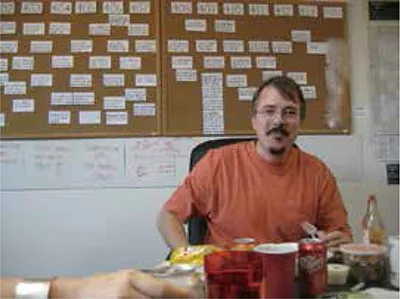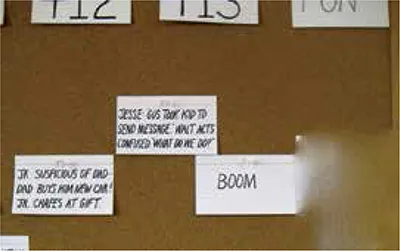
eBook - ePub
The User's Journey
Storymapping Products That People Love
Donna Lichaw
This is a test
Buch teilen
- 160 Seiten
- English
- ePUB (handyfreundlich)
- Über iOS und Android verfügbar
eBook - ePub
The User's Journey
Storymapping Products That People Love
Donna Lichaw
Angaben zum Buch
Buchvorschau
Inhaltsverzeichnis
Quellenangaben
Über dieses Buch
Like a good story, successful design is a series of engaging moments structured over time. The User’s Journey will show you how, when, and why to use narrative structure, technique, and principles to ideate, craft, and test a cohesive vision for an engaging outcome. See how a “story first” approach can transform your product, feature, landing page, flow, campaign, content, or product strategy.
Häufig gestellte Fragen
Wie kann ich mein Abo kündigen?
Gehe einfach zum Kontobereich in den Einstellungen und klicke auf „Abo kündigen“ – ganz einfach. Nachdem du gekündigt hast, bleibt deine Mitgliedschaft für den verbleibenden Abozeitraum, den du bereits bezahlt hast, aktiv. Mehr Informationen hier.
(Wie) Kann ich Bücher herunterladen?
Derzeit stehen all unsere auf Mobilgeräte reagierenden ePub-Bücher zum Download über die App zur Verfügung. Die meisten unserer PDFs stehen ebenfalls zum Download bereit; wir arbeiten daran, auch die übrigen PDFs zum Download anzubieten, bei denen dies aktuell noch nicht möglich ist. Weitere Informationen hier.
Welcher Unterschied besteht bei den Preisen zwischen den Aboplänen?
Mit beiden Aboplänen erhältst du vollen Zugang zur Bibliothek und allen Funktionen von Perlego. Die einzigen Unterschiede bestehen im Preis und dem Abozeitraum: Mit dem Jahresabo sparst du auf 12 Monate gerechnet im Vergleich zum Monatsabo rund 30 %.
Was ist Perlego?
Wir sind ein Online-Abodienst für Lehrbücher, bei dem du für weniger als den Preis eines einzelnen Buches pro Monat Zugang zu einer ganzen Online-Bibliothek erhältst. Mit über 1 Million Büchern zu über 1.000 verschiedenen Themen haben wir bestimmt alles, was du brauchst! Weitere Informationen hier.
Unterstützt Perlego Text-zu-Sprache?
Achte auf das Symbol zum Vorlesen in deinem nächsten Buch, um zu sehen, ob du es dir auch anhören kannst. Bei diesem Tool wird dir Text laut vorgelesen, wobei der Text beim Vorlesen auch grafisch hervorgehoben wird. Du kannst das Vorlesen jederzeit anhalten, beschleunigen und verlangsamen. Weitere Informationen hier.
Ist The User's Journey als Online-PDF/ePub verfügbar?
Ja, du hast Zugang zu The User's Journey von Donna Lichaw im PDF- und/oder ePub-Format sowie zu anderen beliebten Büchern aus Design & Product Design. Aus unserem Katalog stehen dir über 1 Million Bücher zur Verfügung.
Information
CHAPTER 1

Mapping the Story
Making Things Go BOOM!
Why Story?
“You need a road map, a guide, a direction—a line of development leading from beginning to end. You need a story line. If you don’t have one, you’re in trouble.”
—Syd Field,
Screenplay: The Foundations of Screenwriting
Screenplay: The Foundations of Screenwriting
In 2004, I presented my year-end documentary film in graduate school to an audience of around 100 people. As soon as the film ended, before the lights went up, one of my classmate’s hands shot up. I will never forget the first words he uttered—they’re etched into my brain.
I can’t believe you made me sit through that. What was the point?
My film was a dud. It had nothing holding it together: no conflict, no climax, and no resolution—ergo, no story. As a result, I failed to engage my audience. I somehow forgot one of the foundational tenets of filmmaking: if you want to engage your audience, your film must have a story at its foundation.
A website, software, app, service, or campaign—for brevity’s-sake I’ll use the term product for the rest of the book—is similar to a film. They are all things that humans experience. Just like with a film, if you want to engage your audience, your product must have a story at its foundation. You can do this by accident like I did when I created films that people loved. (I did have a few of those, I promise.) Or you can map the story with deliberate care and intent like I eventually learned to do, both as a filmmaker and more recently as someone who helps businesses build products that people love.
Making Things Go BOOM!
Vince Gilligan, creator of the television show Breaking Bad, knows a thing or two about using story to engage an audience. In this photo (see Figure 1.1), he is seated in front of the story map for Season 4.
TV writers are smart. They map the story out before they write a line of dialogue or shoot a single scene. TV shows are large, complex things that are built with large, distributed teams over a long period of time. With so many people, scenes, episodes, and seasons to manage, it’s hard to stay focused on the big picture. Mapping the story on a wall helps TV writers plot a course while keeping the big picture in mind.

FIGURE 1.1
Vince Gilligan, creator of Breaking Bad, in front of a story map for season 4.
Vince Gilligan, creator of Breaking Bad, in front of a story map for season 4.
Mapping the story also helps TV writers build a product that engages an audience by adhering to a millennia-old architecture designed for engagement: a well-crafted story. You’ll learn more about story architecture in Chapter 2, but in the meantime, consider this meticulously placed card near the end of the storyline for Breaking Bad, Season 4 (see Figure 1.2). This card has one word written on it: “BOOM.” If you’ve seen Season 4 of Breaking Bad, you know what this refers to. If you haven’t, you can imagine. Mapping the story helps TV writers make things go BOOM. And it will help you, someone who builds products, make things go BOOM as well.
Story is why people tune in and stayed tuned in, whether you’re creating a TV show, a movie, or a website. Storymapping is how you make that story happen, whether you’re a screenwriter or a product person.

FIGURE 1.2
A close-up of a story card for Breaking Bad.
A close-up of a story card for Breaking Bad.
Storymapping is just what it sounds like: mapping out an intended experience of use for a product, plot point by plot point. This concept of mapping stories is not new. It’s something that Aristotle started doing a very long time ago as he sought to understand what it was about Greek dramas that enraptured audiences, so their success could be reproduced. It’s something screenwriters have been doing for years. It’s something I eventually learned to do for films and more recently with products. And it’s something that you can do on your next project or product.
Why Story?
Story is one of the most powerful tools that humans use to understand and communicate with the outside world. Part evolutionary feature, part survival mechanism harking back to Paleolithic times, part communication tool—story powers the human brain. Story-based cognitive function is so powerful that neuroscientists have a term for it when it doesn’t work: dysnarrativia, the inability to understand or construct stories. Narrative cognition is so central to how humans operate that not having it is debilitating. Like living with amnesia, it is difficult, if not impossible, to function normally. Story, and its underlying architecture, powers the ability to understand what happened in the past, what happens in the moment, or what will happen in the future. It’s a framework and a lens with which humans comprehend everything.
Whether you plan for it or not, your customers use their story-driven brains to understand your product and what it’s like to use your product. They also use their story-driven brains to tell others about your product. The better the story, the better the experience, the better the word of mouth.
More specifically, when people experience something with a story at its foundation—whether it entails watching a movie, riding a roller-coaster, or using a website—their brains are activated. They are more likely not just to have a good experience, but to:
• Remember the experience.
• See value in what was experienced.
• See utility in what they did during that experience.
• Have an easier time doing whatever they were trying to accomplish.
• Want to repeat that experience.
All of this fits under the umbrella of engagement.
If you’re in the business of building products that engage, it’s your job to consider the story that you and your business want your customers to experience. In this book, you will learn how to map that story—or stories—and align everything you and your business do so that it supports that story. For your customer. And your business.
It works for movies, and it will work for you.
NOTE THE OR A STORY VS. STORY
It may look as if I’ve made a mistake throughout this book by using the word “story” without an article in front of it, i.e., the story. It’s no mistake. Story is as much of a tool and framework as it is a discipline. Like art. Or science. When I use “story” without the article, I’m talking about story as a tool. For example, I might say “use story to turn data into insights.” However, if I refer to “a story” or “the story,” I’m referring to the thing you will create and weave throughout your work.
CHAPTER 2

How Story Works
Story Has a Structure
Building Products with Story
“For, the more we look at the story (the story that is a story, mind), the more we disentangle it from the finer growths that it supports, the less shall we find to admire. It runs like a backbone—or may I say a tape-worm, for its beginning and end are arbitrary.”
—E. M. Forster,
Aspects of the Novel
Aspects of the Novel
Humans are sense-making creatures, and story is our most critical sense-making tool. As humans, we’ve evolved and innovated story over millennia as a way to understand our world. For example, there is evidence that ancient cave dwellers learned how to trap an animal and not go hunting alone through the use of stories.
Given how long we’ve lived with story, it’s not surprising that Aristotle uncovered a working model for it long ago. Basically, he said that every story needs three things: characters, goals, and conflict. What weaves these elements together is a structure or a series of actions and events that have a shape to them.
Fortunately, story and its underlying structure is straightforward, simple, and can be easily learned. That’s why it’s so powerful—for books, films, and products.
NOTE STORY VS. NARRATIVE VS. PLOT
Don’t think that you’re alone if you confuse the words story, storyline, plot, and narrative as they are often used interchangeably. Even the dictionary will define them similarly. While story or narrative can refer to the broader version of events, and plot or storyline breaks down the “plan” or series of actions and events that lead up to the story, I use them in this book interchangeably. The reason for this is that a story without a plot or storyline (i....